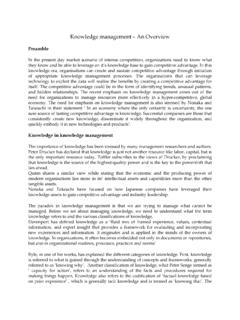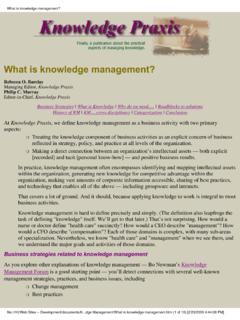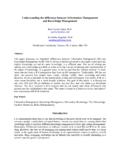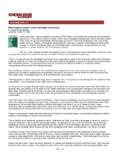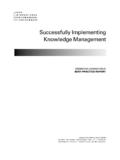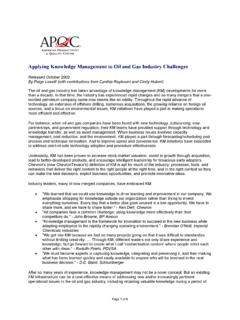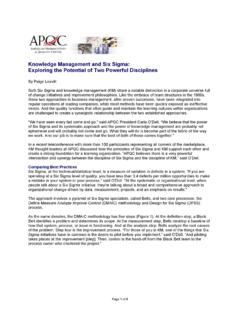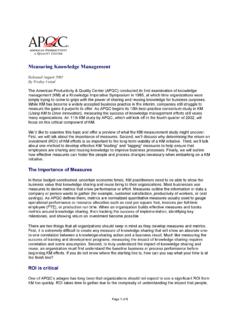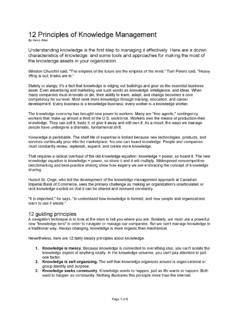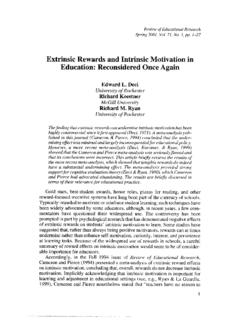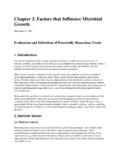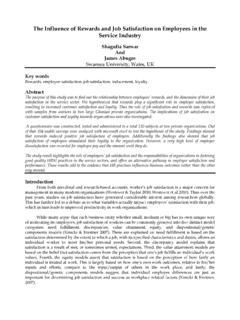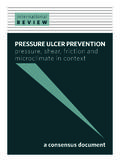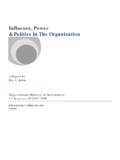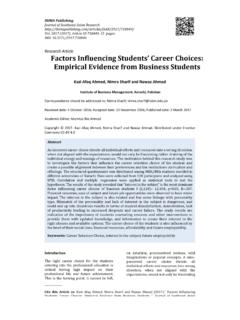Transcription of Rewarding Innovation - Provider's Edge
1 Rewarding Innovation By Paige Leavitt Asking employees to be innovative may seem easy enough. But fostering a creative environment and leveraging valuable ideas that result in viable new products and processes have proven to be quite a challenge. So what can help? To drive Innovation , organizations must determine what works in an Innovation context. How do behavior, motivation, appreciation, social cohesion and allegiance, engagement and commitment, and attitudes and feelings come into play? And how can structured rewards and recognition encourage employees to change their behavior? The American Productivity & Quality Center (APQC) has found that to drive Innovation in products and services, an organization needs innovative approaches to rewards and recognition.
2 Given that employees have valid needs for achievement, status, and affiliation, organizations are tasked with providing structure and consistency that will motivate employees to pursue creative and effective ideas. In working with APQC member companies and generating research for the upcoming Best-Practice Report Using Knowledge Management to Drive Innovation , APQC has found compelling examples of rewards and recognition from historically innovative organizations. The following examples, along with the expert opinion of APQC KM specialist Kimberly Lopez, can serve as a starting point for creating an environment that encourages Innovation . "It requires a blending of creativity with business processes to ensure good ideas become of value to the company," said Lopez.
3 "Supporting a creative environment requires Innovation to be recognized, nurtured, and rewarded." The Basics Those leading organizations that drive Innovation through rewards and recognition first addressed the basic principles of encouraging specific behaviors. Create a design team. Consistently acknowledge those who contribute ideas, knowledge, and time. Senior management may recognize innovative design teams and champions, whereas peers typically nominate and recognize teammates for their contributions to the overall effort. Provide special recognition to volunteers, change agents, and model innovators. Keep names associated with contributions.
4 Disseminate success stories concerning invention of a successful new product or approach. Make Innovation self- Rewarding . Being perceived as an expert by peers and management matters. Link Innovation to the core cultural values of the organization. Explain the justification behind rewards and how meeting goals will affect overall and individual outcomes. Compile a committee of human resources, knowledge management, research and development, and representatives from business units to develop guidelines and suggestions to encourage Innovation . "Organizations typically have experience encouraging certain productive behaviors," said Lopez. "Many of Page 1 of 4 those lessons learned can be the foundation to encourage Innovation from employees.
5 " Design Issues As with all organizational rewards and recognition, balancing intrinsic and extrinsic motivation is a challenge. intrinsic motivation refers to an internal desire to act, such as when the task itself seems Rewarding and meets a person s goals. extrinsic motivation refers to external encouragement to act in order to meet a final reward. "In recent studies at APQC, best-practice organizations were more likely to explicitly attempt to motivate for Innovation ," said Lopez. When an organization establishes extrinsic rewards for Innovation , it must be wary of: attributing more importance to money than it actually has, confusing compensation with rewards, stifling teamwork through individual recognition, ignoring the underlying issues behind behaviors, and a reward s decreased effectiveness over time.
6 To instill intrinsic motivation, several innovative organizations have encouraged peer recognition, arranged events, and established work structures conducive to cultivating relevant innovations. Yet establishing a structure for rewards and recognition involves more than just following a list of guidelines and principles. Challenges lie in ensuring consistency across an organization, yet recognizing the needs of different business units. For instance, innovative sales approaches obviously are separate from innovative manufacturing activities. As a result, best-practice organizations develop guidelines instead of an imposing corporatewide approach. Organizations must also thoroughly flesh out the structure to administer the reward system: Who decides who gets recognized?
7 How are innovations defined? In addition to innovators, should enablers be rewarded? For each question, there is a delicate balance of pros and cons. For example, it may seem appropriate to let supervisors determine who should be rewarded. After all, they see who commits effort. But this may encourage employees to conceal problems from the persons who could help them. "When supervisors hold control of rewards, employees are less likely to discuss or share failures that can stifle Innovation or important lessons," said Lopez. "Don't establish a reward system that will create a fear of failure within the organization." Organizations are also tasked with determining how much emphasis should be placed on recognizing innovative behavior instead of results.
8 Boeing Rocketdyne has faced issues from recognizing and Rewarding the successes of employees. The company has several programs to reward innovative employees, including its Leading Edge award, the Pillar award, and the Engineer of the Year award. Furthermore, an innovator could also be promoted. But the result of recognizing individuals is that cooperation is avoided and knowledge may be hoarded. At Boeing Rocketdyne, there is a growing belief that Innovation comes from an intrinsic sense of motivation and that a reliance on external motivation can stifle cooperation. "An organization cannot create a climate for Innovation and knowledge sharing without finding a balance between intrinsic and extrinsic motivators for its employees," said Lopez.
9 "If intrinsic motivation declines, it will take more and more extrinsic rewards to maintain the behavior. And competition for rewards may negatively impact teamwork." Some organizations have found that recognizing individual achievement is critical for them. Especially when a project involves an extended time frame, recognizing and encouraging innovative behavior must come well before revenue is realized. Organizations operating under the mantra that justice delayed is justice denied often create a close proximity between behavior and rewards. "For best-practice organizations such as NASA and Millennium Pharmaceuticals, a project, whether it is space exploration Page 2 of 4 or taking a drug to market, can occur over decades.
10 It is important for these organizations to recognize their experts at the time of the accomplishment." Peer Recognition APQC has found at many historically innovative organizations that extrinsic rewards can actually impede Innovation . "As extrinsic motivation -- or the perception by the person that they are acting because of extrinsic motivation -- increases, intrinsic motivation can decline," said Lopez. "Additionally, focusing on monetary rewards as extrinsic motivators can add further complications. Issues arise when you attribute more importance to money than it actually has and make money more prominent than it needs to be." Instead of monetary rewards for innovators, 3M relies primarily on peer recognition to encourage Innovation .
